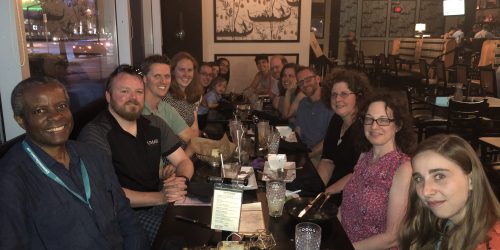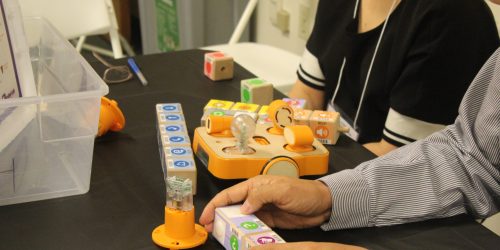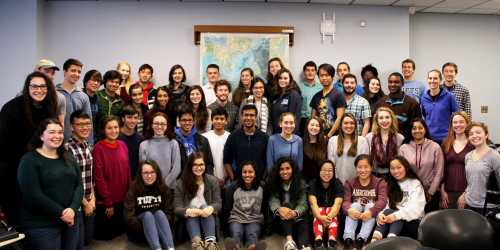First-Year Intro-to-Engineering Simple Robotics
by Ethan Danahy, Research Assistant Professor, CEEO
 Once again, in Fall 2016, Professor Danahy taught the Tufts School of Engineering’s introduction to engineering course Simple Robotics to first-year engineering students. Leveraging the LEGO MINDSTORMS robotics hardware and the LabVIEW Graphical Programming interface, this course has pre-major engineering students work in teams on weekly assignments to design, create, build, and demonstrate/present their robotic solutions. The challenges included standard ones in which students engage every year, like creating bio-inspired robotic animals, implementing a Haunted House at the Tufts CEEO, and building playful experiences for young children. The students were also excited to design simulated astronaut tools, perform robotic magic tricks, and code interactive video games (using the LEGO hardware as the controller and LabVIEW’s front panel controls as the graphical interface). Beyond the technical components of the class, the semester also emphasized group work and collaboration, engineering ethics, documentation and sharing of open-source work, and included visitors from academia and industry to share their perspectives of life after undergrad.
Once again, in Fall 2016, Professor Danahy taught the Tufts School of Engineering’s introduction to engineering course Simple Robotics to first-year engineering students. Leveraging the LEGO MINDSTORMS robotics hardware and the LabVIEW Graphical Programming interface, this course has pre-major engineering students work in teams on weekly assignments to design, create, build, and demonstrate/present their robotic solutions. The challenges included standard ones in which students engage every year, like creating bio-inspired robotic animals, implementing a Haunted House at the Tufts CEEO, and building playful experiences for young children. The students were also excited to design simulated astronaut tools, perform robotic magic tricks, and code interactive video games (using the LEGO hardware as the controller and LabVIEW’s front panel controls as the graphical interface). Beyond the technical components of the class, the semester also emphasized group work and collaboration, engineering ethics, documentation and sharing of open-source work, and included visitors from academia and industry to share their perspectives of life after undergrad.
Robotics and Mechatronics
by Ethan Danahy, Research Assistant Professor, CEEO
 Taking over for Professor Rogers, who had taught this course previously, Professor Danahy took the reigns on the “Robotics and Mechatronics” course taught through the Mechanical Engineering department to juniors and seniors. A new course for Professor Danahy, the goal was to build on concepts that some students may have learned in the first-year Simple Robotics course (for those that took it), and prepare them for taking the Advanced Robotics course offered to graduate students. To act as a bridge, the students started with the LEGO MINDSTORMS robotics hardware, but implemented much more technically rigorous assignments (using proportional control to drive a cab/trailer system, balancing an inverted pendulum, and doing forward/inverse kinematics on a two-link robotic arm). Half way through the semester the National Instruments myRIO microcontroller, along with an associated robotics hardware kit developed at the Tufts CEEO, was introduced to provide the students a wider range of tools for developing their projects in the second half of the course. These assignments opened up the space for creativity and included wearable robotics (in collaboration with the Tufts Art Gallery) as well as implementing learning robots for early elementary students (in collaboration with the Child Development department).
Taking over for Professor Rogers, who had taught this course previously, Professor Danahy took the reigns on the “Robotics and Mechatronics” course taught through the Mechanical Engineering department to juniors and seniors. A new course for Professor Danahy, the goal was to build on concepts that some students may have learned in the first-year Simple Robotics course (for those that took it), and prepare them for taking the Advanced Robotics course offered to graduate students. To act as a bridge, the students started with the LEGO MINDSTORMS robotics hardware, but implemented much more technically rigorous assignments (using proportional control to drive a cab/trailer system, balancing an inverted pendulum, and doing forward/inverse kinematics on a two-link robotic arm). Half way through the semester the National Instruments myRIO microcontroller, along with an associated robotics hardware kit developed at the Tufts CEEO, was introduced to provide the students a wider range of tools for developing their projects in the second half of the course. These assignments opened up the space for creativity and included wearable robotics (in collaboration with the Tufts Art Gallery) as well as implementing learning robots for early elementary students (in collaboration with the Child Development department).
Mechanical Engineering Senior Design Course
by Kristen Wendell, McDonnell Family Professor in Engineering Education
 In the Fall 2016 semester, I taught the mechanical engineering senior design course (ME 43) at Tufts, otherwise known as “capstone.” A goal of mine was for all of my students to be designing mechanical solutions for clients who are part of the Tufts community. I hoped to incorporate themes from the Community-Based Engineering project and strategies from human-centered design. At the same time that I was identifying potential clients, Tufts DevTech researchers Amanda Strawhacker and Miki Vizner were beginning work on their CEEO Innovation grant on early childhood maker spaces. Their goals included developing innovative, developmentally appropriate tools that would create better fabrication and learning opportunities for children. Much to my delight, they were willing to serve as clients, and students from the senior design class worked on two projects for their early childhood maker space: a “Crazy Currents” water table that allows children to explore water flow as an analogy to electrical energy flow, and a child-safe and child-friendly vacuum former. Thanks for being amazing clients, Amanda and Miki!
In the Fall 2016 semester, I taught the mechanical engineering senior design course (ME 43) at Tufts, otherwise known as “capstone.” A goal of mine was for all of my students to be designing mechanical solutions for clients who are part of the Tufts community. I hoped to incorporate themes from the Community-Based Engineering project and strategies from human-centered design. At the same time that I was identifying potential clients, Tufts DevTech researchers Amanda Strawhacker and Miki Vizner were beginning work on their CEEO Innovation grant on early childhood maker spaces. Their goals included developing innovative, developmentally appropriate tools that would create better fabrication and learning opportunities for children. Much to my delight, they were willing to serve as clients, and students from the senior design class worked on two projects for their early childhood maker space: a “Crazy Currents” water table that allows children to explore water flow as an analogy to electrical energy flow, and a child-safe and child-friendly vacuum former. Thanks for being amazing clients, Amanda and Miki!
Advanced Robotics
by Whitney Crooks, TA for Chris Rogers
ME184: Advanced Robotics is a project based course for upper classmen and graduate students taught by Chris Rogers and TAed by Whitney Crooks. Students were given a myRIO and a kit with building materials and sensors and they programmed the robots in LabVIEW. Through the course of the semester, students were given projects such as building a robotic arm that could draw a letter, creating a robotic car controlled by an accelerometer in a steering wheel, and identifying regions in an image that reinforced some of the fundamentals of robotics. The semester culminated in the students designing robots that painted or drew a picture of the Dean of the School of Museum of Fine Arts. A wide variety of robots and artistic techniques were demonstrated live before winter break and included printer-like robots, robotic arms, and a splatter paint robot.




